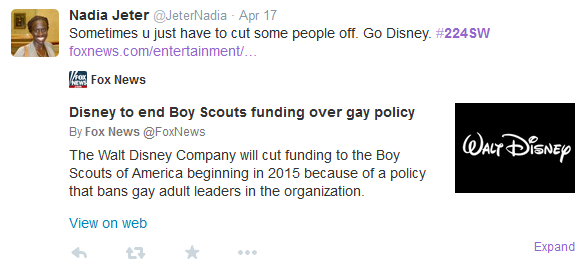Spring 2015 Live Twitter Chat for Social Work Students & Educators
 To help social work students and educators learn about Twitter and develop the skills to participate in a live chat, Jimmy Young of the University of Nebraska-Kearney and I (Laurel Hitchcock of University of Alabama at Birmingham) have designed an assignment for social work students that involves joining a live Twitter chat with other social work students, educators and practitioners from around the country to talk about important social and economic justice issues. The assignment is designed for a policy or macro-practice course, but it can be incorporated into almost any social work course. Here are the some of the details of the assignment:
To help social work students and educators learn about Twitter and develop the skills to participate in a live chat, Jimmy Young of the University of Nebraska-Kearney and I (Laurel Hitchcock of University of Alabama at Birmingham) have designed an assignment for social work students that involves joining a live Twitter chat with other social work students, educators and practitioners from around the country to talk about important social and economic justice issues. The assignment is designed for a policy or macro-practice course, but it can be incorporated into almost any social work course. Here are the some of the details of the assignment:
1. Students watch the documentary Inequality for All, and then write a brief reaction paper to movie.
2. Then, students participate in the live Twitter chat scheduled for March 12, 2015 at 8:00 PM CST. This chat will be sponsored by #MacroSW, a bi-weekly Twitter chat focusing on macro social work practice issues, and hosted by Jimmy and myself. During the chat, we will ask questions about the film and income inequality that will guide the flow of the conversation.
3. After the live chat, students write a brief self-reflection essay about the experience of participating in the chat.
While the written parts of the assignment are optional to participate in the chat, we highly recommend some type of reflection so students are engaged with the content from the documentary prior to the chat, and have an opportunity to critically assess how the experience can inform their future social work practice. We have written in more detail about the assignment on respective blogs (see JimmySW’s Blog) which includes detailed instructions for the assignment, grading rubrics and tips on how to introduce your students to Twitter. Our first chat was held on October 28, 2014, and you can read details about it here, including a transcript of tweets from the conversation. There is no cost to educators or students to participate in the chat, and we welcome anyone, especially social work practitioners, to join the chat.
Because we are working to improve the chat and the assignment as an educational experience for social work students, we are very interested in any feedback from social work educators. Please contact us (by clicking on our names below) if you plan to have your class or maybe a student group participate in the chat. We also welcome questions.
How to cite this post:
Hitchcock, L. I. (2015, February 1). Spring 2015 Live Twitter Chat for Social Work Students & Educators[Blog Post]. Retrieved from https://laureliversonhitchcock.org/2015/02/01/spring-2015-live-twitter-chat-for-social-work-students-educators/.
Q & A: Student Perspective on Twitter Assignment
Ms. Bobbi Arrington (@bobbielle) is an instructor at School of Social Work at Monmouth University. In this blog post Ms. Arrington interviews Ms. Nadia Jeter, a BSW student at Monmouth University, who participated in Twitter assignment during an Human Behavior and the Social Environment course. In another post, Ms. Arrington and Dr. Becky Anthony (@becky_anthony ), an assistant professor of social work at Salisbury University, write about how they developed and managed an assignment using Twitter in their Human Behavior and the Social Environment Courses.
Recently, I sat down with Nadia Jeter, a BSW social work student at Monmouth University. Nadia was in Professor Becky Anthony’s class when the Twitter project was started. Nadia and I sat down in the back of a brightly lit classroom, papers and books cluttered the desk as her last class had just finished. She has a bright infectious smile and a large personality that is charismatic. It’s not surprising that she has become a major advocate for vulnerable and marginalized populations using Twitter. It took just a few seconds for her to recall back to the spring of 2013 and the assignment.
BA: What did you initially think of the assignment?
NJ: I hated it! I asked was it mandatory and Professor Anthony, with her nice smile and her hands folded (she imitates Professor Anthony’s hand expression) she said, “Yes – but don’t worry. We’ll show you how to do it!” I had just got on facebook and I hated it! It wasn’t user friendly.
BA: How was it learning to use Twitter?
NJ: It’s actually very user friendly. I took me all of two minutes to set up. It’s really easy, accept for the fact that you have only one hundred forty characters to express yourself! This was a very good tool for me because it was so simple and I really value simplicity.
BA: How did you develop your tweets and how you responded to replies?
NJ: (she laughs) In the end I was actually very thankful that you only have one hundred forty characters! Having only a few words made you choose what was important. You had to take out the bread and just give the meat. Because…yeah…you have to just give them a fact. No explanation. So if you retweet an article you just give them a brief statement. Say you’re reading something and you say to yourself…this is so corrupt. You can retweet and just say “corruption in the judicial system.” The person has to look to see what you are talking about.
Twitter Project for HBSE Course
Dr. Becky Anthony (@becky_anthony) is an assistant professor in the Department of Social Work at Salisbury University and Ms. Bobbi Arrington (@bobbielle) is an instructor at School of Social Work at Monmouth University. In this blog post, they write about how they developed and managed an assignment using Twitter in their Human Behavior and the Social Environment Courses. In another post, Ms. Arrington interviews Ms. Nadia Jeter, a BSW student who completed the assignment.
As professional users of Twitter, we understand how social media can be utilized to share knowledge, resources, and information. As professors, we wondered would students be able to gain similar professional benefits if they utilized social media, specifically Twitter, in the classroom. To help us answer this question, we created the “Twitter Project” for our Human Behavior and the Social Environment (HBSE) students.
Based on the course design where the content of each week is about a specific diverse community, we assigned students into groups and gave each group a specific diverse community. These communities included: religious communities, people with disabilities, social classism in the United States, African Americans, Native Americans, Asian Americans, Latino Americans, and LGBTQ populations. Each student was asked to post, using our classroom hashtag, two tweets per week about their assigned community. They were encouraged to post about news, current events, and advocacy opportunities, focusing on examples of social and economic injustice. Learners were graded based on writing two posts (or tweets) per week. The assignment was worth eight points. A student received a point each week they posted two tweets that advocated on behalf of an issue that affected their particular population.
Follow-up to 10/28 #MacroSW Twitter Chat
How do you get social work students passionate about policy issues? Jimmy Young and I have an answer for you – live Twitter chats! We were overwhelmed with the response from social work educators and students to our live Twitter Chat last Tuesday, October 28th. My best estimate is that close to 200 people, mostly students from at least six universities across the country, participated in our one-hour chat about income inequality. You can read a copy of the transcript from the chat here. What I observed during the chat was that students were engaged in open, thoughtful and respectful conversations about the problems in our country due to the wide income gap between the rich and poor.
site
The chat was hosted by the #MacroSW Chat folks who graciously allowed Jimmy and I to co-moderate a discussion about the film Inequality for All. When organizing this event, we targeted to social work students in social welfare policy and macro practice classes. Click here to read about how we set up the chat and developed an assignment using Twitter.
Many thanks to #MacroSW Chat, especially Pat Shelly (@PatShellySSW) of the University of Buffalo School of Social Work and Karen Zgoda (@karenzgoda), Instructor at Bridgewater State University, who sponsored and promoted our chat. And a big thanks to everyone who participated in the chat – including social work students and educators from Appalachia State, Bridgewater State University, California State University – Long Beach, Tarleton State University, University of Alabama at Birmingham, University of Buffalo School of Social Work, and the University of Nebraska Kearney.
How to cite this post:
Hitchcock, L. I. (2014, November 7). Follow-up to 10/28 #MacroSW Twitter Chat[Blog Post]. Retrieved from https://laureliversonhitchcock.org/2014/11/07/follow-up-to-1028-macrosw-twitter-chat/.
Is social media “creeping” into field education?
Social and digital media are creeping into social work practice. This is how Mishna and her colleagues (2012) describe the development of online communication technologies in social work practice (including the use of email, texting and social networking sites such as Facebook). In their qualitative study, they interviewed 15 licensed social work practitioners about their use of online communication tools with clients and discovered that social and digital media tools appear to be changing how social workers interact with clients, for better or worse. One of the more significant themes they reported was that digital communication is being driven by client need/demand and that ethical boundaries may be crossed before a social worker even realizes what happened.
If social media and other online communication tools are creeping into social work practice at the agency and community levels, then it must also be creeping into social work field education. How? And more importantly, how are we as a profession managing it in field education? I don’t teach social work field education, but I am always interested in how my courses inform and help students transition to field education during their last semester of BSW education. Specifically, I want to understand how social and digital media are becoming a part of field education and how are students, field educators and field agencies using these tools.
For the past few semesters, I have incorporated a Twitter assignment into my macro practice course which students in our program take the semester before their field placement. Every semester I observe how they carry their newfound knowledge and skills with social media into their field agencies. I recently wrote an article for the Field Educator about these observations, which range from deleting their Twitter account to creating and managing a Twitter account for their field placement agency. While I am a sample size of one, I talk with field educators every chance I get, asking what they are doing with social media. Recently, one field director told me she had her students ask their field instructors about the agency’s social media policy (a statement about who can post what on social media related to the agency) on the first day. If the agency doesn’t have a social media policy, then the students were required write a social media policy for the agency and present it to senior management as part of their learning contract. She said it has been a very successful task for both the students and their field agency partners. We also talked about the possibility of students writing their own social media policies, a statement that looks a lot like informed consent where a student articulates when, how, where and why they will or will not interact with clients or communities via social media. This step helps the students articulate their ethical boundaries in advance, before they find themselves in the middle of an ethical dilemma with a client or agency and not sure how they got there.
Using Innovative Content to Tell the Social Work Story by Chris Ingrao
 Mr. Chris Ingrao is the Community Manager of SocialWork@Simmons, the online Masters of Social Work program, offered through the Simmons College School of Social Work. In this blog post, Mr. Ingrao writes about how digital technologies can be used to curate content about the history of social work.
Mr. Chris Ingrao is the Community Manager of SocialWork@Simmons, the online Masters of Social Work program, offered through the Simmons College School of Social Work. In this blog post, Mr. Ingrao writes about how digital technologies can be used to curate content about the history of social work.
The possibilities are endless when it comes to curating content for social workers. There is a seemingly infinite amount of topics that touch the lives of professionals in micropractice that are worth sharing. However, I have found that the history behind the profession is rarely discussed. Despite having immersed myself in all things social services for some time now, I discovered that I too knew very little about the historical milestones and legislative shifts that ultimately resulted in what we now know as modern day social work. As a result, our team performed research around the origins of the social services industry and created a chronological resource documenting the evolution of the profession.





